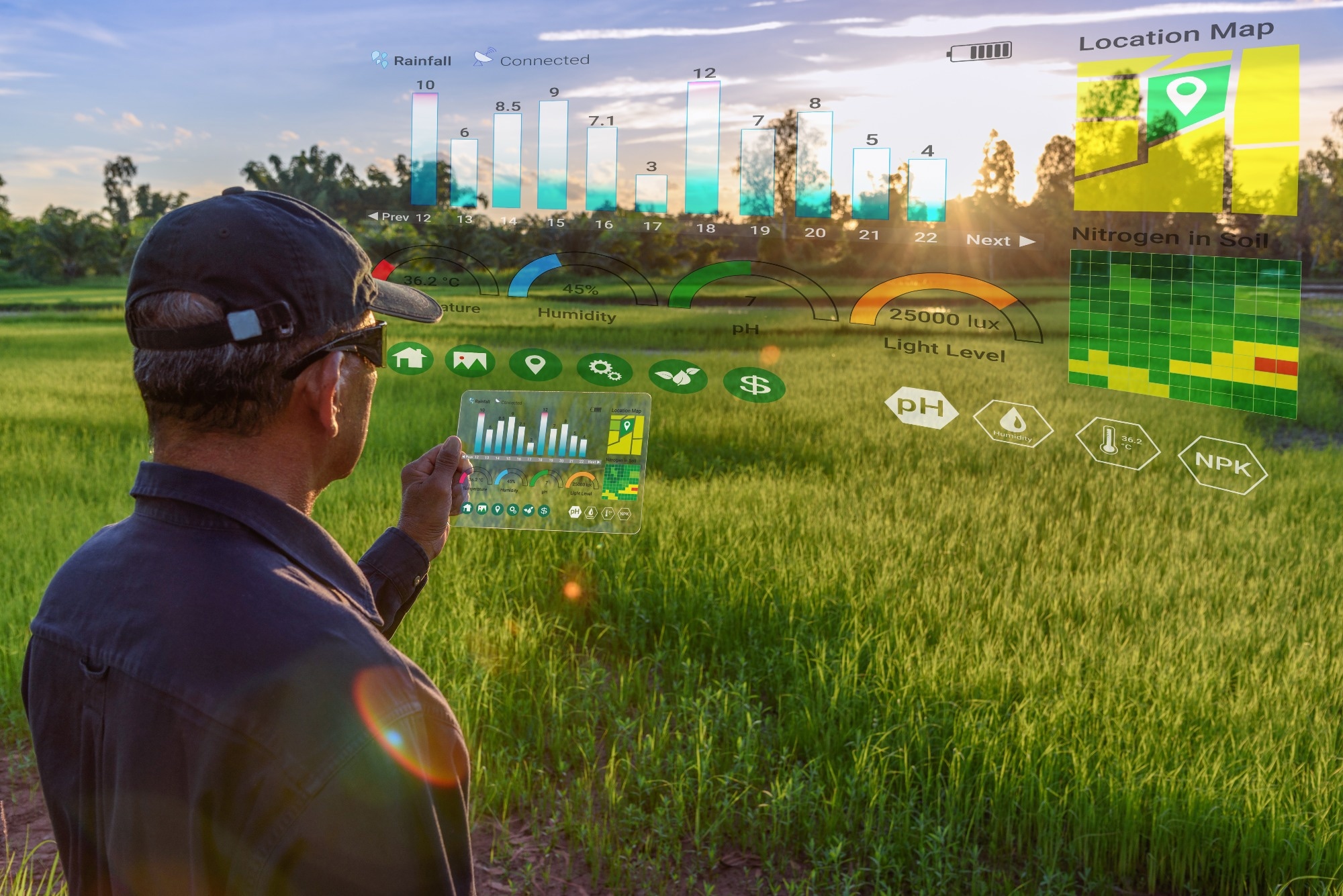Digital innovations are revolutionizing modern agriculture as farms are becoming increasingly connected and are progressively becoming highly interconnected systems. The Internet of Things plays a particularly significant role in this revolution, as it ties diverse technologies into the fabric that is technologically advanced farming.
The central role of IoT in modern farming
According to Shafiq et al. (2022), the Internet of Things (IoT) refers to a network of physical devices, vehicles, home appliances, and other items embedded with electronics, software, sensors, actuators, and connectivity, enabling these objects to connect and exchange data. IoT, therefore, does not represent “the internet” but encompasses the hardware and software technologies involved in the connection process, from data sensors to web-based processing. The internet, therefore, plays a small part in the IoT universe as it represents the web-formatted information that has been obtained, processed, and uploaded.
From drones to environmental sensors, IoT technologies across sectors are emerging rapidly with diverse interdisciplinary applications, many of which are in agriculture. According to Polaris Research, the global smart agriculture market size, in which the IoT plays the most significant role in, was valued at USD 13.17 billion in 2021 and is anticipated to grow USD 32.1 Billion by 2030.
Compared to previous generations, the IoT has enabled farmers to collect and access a wealth of data and information previously unavailable in previous eras. Farmers can now use the internet to access weather forecasts, market prices, and other information to inform decisions about short and long-term operations. As a result, the IoT is an invaluable tool for modern-day farmers.
Benefits and applications of IoT in farming
In a scientific literature review study from 2022 published in the Annals of Emerging Technologies in Computing, authors collected studies applying IoT to aspects of farming to decipher the underlying technological trends in agriculture. The authors collected information on the scope, methodology, and results from studies published between 2015 and 2020.
Findings demonstrated that IoT is applied broadly to agricultural systems but plays the most significant role in automation. IoT plays a particularly pivotal role in the shift towards so-called ‘smart farming’, the transition towards automated operation systems. IoT is crucial as it provides the mechanized hardware, software, and connection required to conduct this operation. As a result, the review found most studies of IoT focused in some way on the development of autonomous assistive systems in agriculture.
Many studies considering IoT in agriculture found diverse benefits, as discussed in a 2021 review by Moysiadis examining smart farming in Europe. On a continental scale, IoT and smart farming not only improve agricultural productivity but also impact stakeholder welfare by cutting labor costs and consumer behavior by providing rigorous standardized production practices and ecological dynamics by reducing damaging practices such as optimizing pesticide usage. Further effects of IoT are also particularly beneficial for stakeholders.
For instance, the IoT is especially effective as a tool for analysis, adaptation, and connectivity among farming networks. The IoT can gather many types of data at a rate and size unforeseen in human history, allowing agricultural systems to respond to situations rapidly and effectively to measured changes in environmental conditions or demand. As a tool for connection, the IoT allows stakeholders to communicate with consumers and other stakeholders, share best practices and information, and form large cooperatives easily.

Image Credit: William Potter/Shutterstock.com
The future of IoT in a smart farming world
Increasingly interconnected and automated farming networks are becoming progressively feasible through more effective, affordable, and available technologies. Farms are becoming closer to operating as systems that can respond quickly to real-time temperature changes, pest detection, water supply, and many other biotic or abiotic conditions without human intervention. Future farms may therefore have little to no manual labor, collect long-term datasets from basing current and future agricultural operations, and provide integrated data for institutions to adapt policies or productivity targets.
However, several challenges on a broad spatial and temporal scale face this kind of future for agriculture. For example, the disparity in socioeconomic capacities will drive major differences among countries. In a world experiencing unpredictable changes in climate due to global warming and the effects of human activities, this disparity will have major consequences for economies in regions that cannot afford or maintain adaptive systems.
On a finer scale, technological challenges pose a significant threat. In a gradually more automated world, especially in agriculture, the security of systems must be at the forefront of cybernetic innovations. If the food production of a nation can be accessed online, ransomware, cyberattacks, or simple system bugs may induce profound consequences on national and potentially international scales due to the extent of modern interconnectivity.
Nevertheless, the future of agriculture will most likely incorporate increasingly more elements of smart farming related to the IoT. The economic, agricultural, and ecological interests invested in IoT technologies are generating considerable accelerations in innovations, which are rapidly integrating into farms. In a world with a growing human population, such innovations will be integral to maintaining food security and mitigating the effects of global climate change.
Sources:
- Farooq, H., Rehman, H. U., Javed, A., Shoukat, M., & Dudely, S. (2020). A Review on Smart IoT Based Farming. Annals of Emerging Technologies in Computing, 4(3), 17–28. https://doi.org/10.33166/aetic.2020.03.003
- Gupta, M., Abdelsalam, M., Khorsandroo, S., & Mittal, S. (2020). Security and Privacy in Smart Farming: Challenges and Opportunities. IEEE Access, 8, 34564–34584. https://doi.org/10.1109/access.2020.2975142
- Moysiadis, V., Sarigiannidis, P., Vitsas, V., & Khelifi, A. (2021). Smart Farming in Europe. Computer Science Review, 39, 100345. https://doi.org/10.1016/j.cosrev.2020.100345
- Shafiq, M., Gu, Z., Cheikhrouhou, O., Alhakami, W., & Hamam, H. (2022). The Rise of “Internet of Things”: Review and Open Research Issues Related to Detection and Prevention of IoT-Based Security Attacks. Wireless Communications and Mobile Computing, 2022, 1–12. https://doi.org/10.1155/2022/8669348
- Smart Agriculture Market Size & Share Global Analysis Report, 2022-2030. (n.d.). Polaris Market Research. Retrieved January 17, 2023, from www.polarismarketresearch.com/.../smart-agriculture-market
- Smart Farming in 2020: How IoT sensors are creating a more efficient precision agriculture industry. (2021, March 2). Business Insider. www.businessinsider.com/smart-farming-iot-agriculture
Further Reading